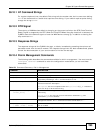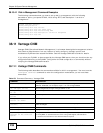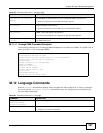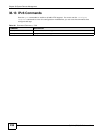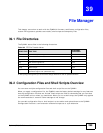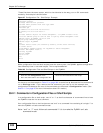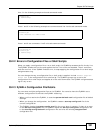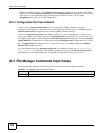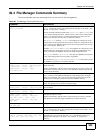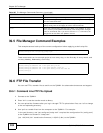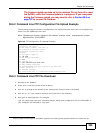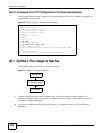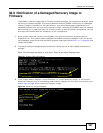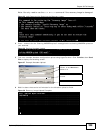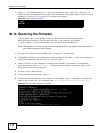
Chapter 39 File Manager
ZyWALL (ZLD) CLI Reference Guide
303
39.4 File Manager Commands Summary
The following table lists the commands that you can use for file management.
Table 185 File Manager Commands Summary
COMMAND DESCRIPTION
apply /conf/file_name.conf [ignore-
error] [rollback]
Has the ZyWALL use a specific configuration file. You must still use the
write command to save your configuration changes to the flash (“non-
volatile” or “long term”) memory.
Use this command without specify both ignore-error and rollback: this
is not recommended because it would leave the rest of the configuration
blank. If the interfaces were not configured before the first error, the
console port may be the only way to access the device.
Use ignore-error without rollback: this applies the valid parts of the
configuration file and generates error logs for all of the configuration file’s
errors. This lets the ZyWALL apply most of your configuration and you can
refer to the logs for what to fix.
Use both ignore-error and rollback: this applies the valid parts of the
configuration file, generates error logs for all of the configuration file’s
errors, and starts the ZyWALL with a fully valid configuration file.
Use rollback without ignore-error: this gets the ZyWALL started with
a fully valid configuration file as quickly as possible.
You can use the “apply /conf/system-default.conf” command to reset
the ZyWALL to go back to its system defaults.
copy {/cert | /conf | /idp | /
packet_trace | /script | /tmp}file_name-
a.conf {/cert | /conf | /idp | /
packet_trace | /script | /tmp}/
file_name-b.conf
Saves a duplicate of a file on the ZyWALL from the source file name to the
target file name.
Specify the directory and file name of the file that you want to copy and
the directory and file name to use for the duplicate. Always copy the file
into the same directory.
copy running-config startup-config Saves your configuration changes to the flash (“non-volatile” or “long
term”) memory. The ZyWALL immediately uses configuration changes
made via commands, but if you do not use this command or the write
command, the changes will be lost when the ZyWALL restarts.
copy running-config /conf/file_name.conf Saves a duplicate of the configuration file that the ZyWALL is currently
using. You specify the file name to which to copy.
delete {/cert | /conf | /idp | /
packet_trace | /script | /tmp}/file_name
Removes a file. Specify the directory and file name of the file that you
want to delete.
dir {/cert | /conf | /idp | /
packet_trace | /script | /tmp}
Displays the list of files saved in the specified directory.
rename {/cert | /conf | /idp | /
packet_trace | /script | /tmp}/old-
file_name {/cert | /conf | /idp | /
packet_trace | /script | /tmp}/new-
file_name
Changes the name of a file.
Specify the directory and file name of the file that you want to rename.
Then specify the directory again followed by the new file name.
rename /script/old-file_name /script/
new-file_name
Changes the name of a shell script.
run /script/file_name.zysh Has the ZyWALL execute a specific shell script file. You must still use the
write command to save your configuration changes to the flash (“non-
volatile” or “long term”) memory.
schedule-run 1 file_name.zysh {daily |
monthly | weekly} time {date | sun | mon
| tue | wed | thu | fri | sat}
Has the ZyWALL execute the specified specific shell script file at the the
specified time. You must still use the
write command to save your
configuration changes to the flash (“non-volatile” or “long term”)
memory.



